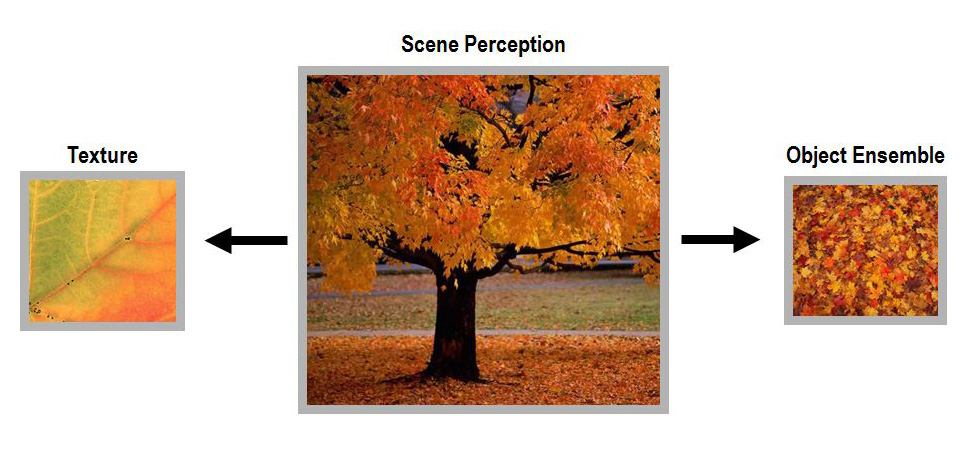Research
The human visual system is proficient at recognizing objects, and does so by flexibly utilizing various types of visual cues, such as an object’s shape and surface properties (e.g. color and texture). Over the past two decades, a majority of fMRI studies of object recognition have focused on the processing of shape. While shape is certainly a powerful cue, surface-based visual cues such as color and texture can also be quite diagnostic to recognition.
Yet, compared to the processing of shape, we know comparatively less about the neural substrates of surface-property perception. Thus, a major goal of my past and current research has been to use both behavior and fMRI to understand the separate but complementary processes which promote successful object recognition. Moreover, given that our visual system evolved to process information from a complex and dynamic landscape, I am interested in how object recognition relates to scene recognition, and how we ultimately use perceptual information to successfully interact with objects in our environment. Below I outline a number of different lines of research that will continue to receive attention in my laboratory.
1. Separate cortical pathways for the processing of shape versus surface properties
Using fMRI, I have demonstrated that processing object shape preferentially activates a lateral region of occipito-temporal cortex known as the lateral occipital area (LO) whereas processing the surface properties of objects (particularly texture) preferentially activates medial regions of the ventral stream (Cant, & Goodale, 2007, Cerebral Cortex; Cant, Arnott, & Goodale, 2009, Experimental Brain Research). Interestingly, the region most consistently activated by the processing of surface properties overlaps with the scene-sensitive parahippocampal place area (PPA). Moreover, a region spatially intermediate to area LO and the PPA, located on the fusiform gyrus and overlapping the face-sensitive fusiform face area (FFA), showed sensitivity to processing both shape and surface properties.
Based on these findings, I developed a model which posits that the organization of high-level visual cortex is based not only on the stimulus category to which a regionally maximally responds (i.e. objects, scenes, and faces), but also on the stimulus attributes that best support the processing of that category (i.e. shape for objects, texture for scenes, and shape, texture and color for faces). This model is supported by a range of behavioral studies on object, scene and face recognition, and I believe this model may also shed light on the organization of other cortical sensory systems (e.g. in the auditory and somatosensory domains). Finally, this account may offer new insights into the diagnosis and rehabilitation of individuals who suffer from specific vision problems following cerebral damage (namely, individuals who cannot perceive form and suffer from visual form agnosia, and individuals who cannot perceive color and suffer from cerebral achromatopsia).
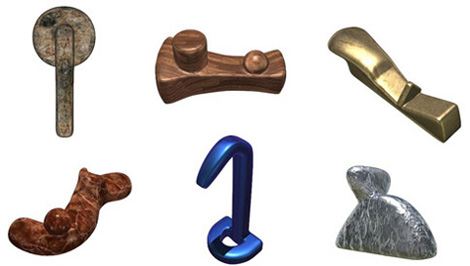
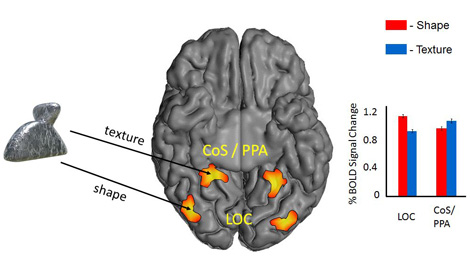
2. The processing of shape versus surface properties: insights from behavioral studies
The above findings contribute a great deal to our understanding of the neural substrates of object perception. But demonstrating that separate brain regions process shape and surface properties does not necessarily imply that these regions function independently. Thus, to investigate this presumed independence, I used a behavioral attentional paradigm and showed that the regions involved in the perception of shape and surface properties can function independently – at least when perceiving surface cues means perceiving the material properties of objects (Cant et al., 2008, Perception).
In fact, the textures on the objects used in my previous studies were always clearly linked with the materials the objects were made of (e.g. marble, brick). But even though surface cues are commonly associated with particular materials (e.g. a marble texture reveals that an object is smooth, heavy, and rigid), they can also provide cues to an object's 3-D shape. Thus, using the same attentional paradigm but with stimuli where texture contributed more directly to the perception of 3-D shape (e.g. convex or flat surface textures), I now found that shape and surface properties are not processed independently, and instead share common processing resources (Cant & Goodale, 2009, Journal of Vision).
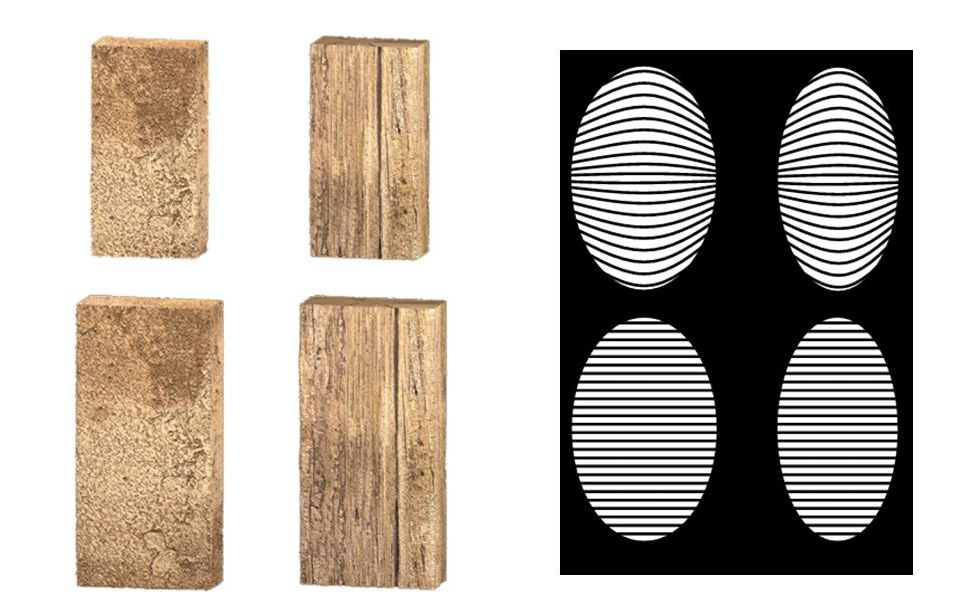
3. Scratching beneath the surface: new insights into the properties of area LO and the PPA
Taken together, my previous fMRI and behavioural studies suggest that surface cues are processed by two separate networks: one in which surface cues reveal an object’s shape and another in which surface cues signal its material properties. Using fMRI, I recently provided evidence for this idea (Cant & Goodale, 2011, Journal of Neuroscience). In short, attending to the shape (flat/convex) of a circular surface activated area LO, whereas attending to the texture (wood/rock) or material properties (soft/hard compliances) of the same circular surfaces activated a region that overlapped with the PPA.
These results demonstrate that there are different neural substrates for the different types of information that a visual surface signals. With regard to object shape, the organization of area LO may be complex, with neurons involved in processing both outline shape and surface curvature independent of contour. Moreover, to my knowledge this is the first study to demonstrate that processing texture, which occurs within the scene-sensitive PPA, is a route to accessing knowledge about an object’s material properties (specifically, whether the object has a soft or hard compliance). This finding will be of interest to scientists studying both object and scene recognition, as it suggests that texture and material properties contribute to scene representation.
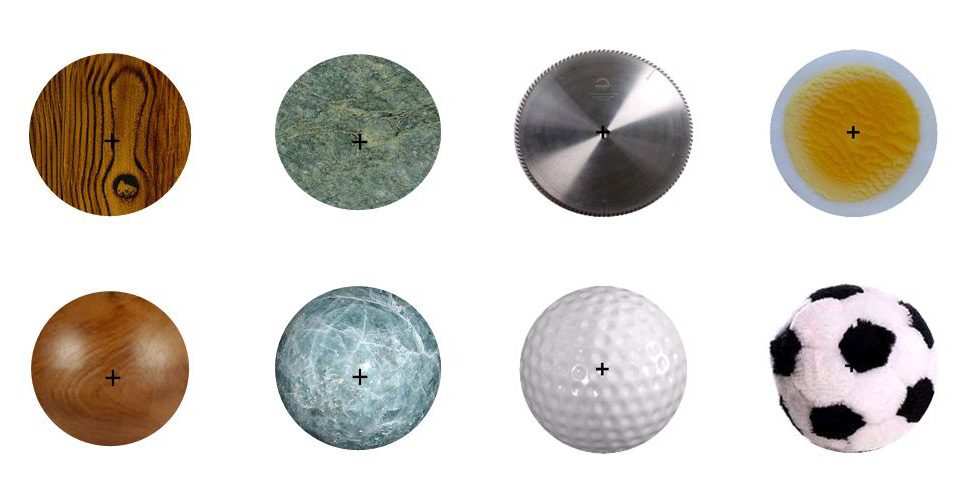
4. The flipside of object individuation: neural representation for object ensembles
A number of behavioral studies have shown that we can extract summary statistics from large collections of objects without forming detailed representations of the individual objects in the ensemble. Since objects in our visual world are rarely seen in isolation (e.g. leaves on a tree), such object-ensemble representation is adaptive and complements object-specific processing by allowing us to overcome the capacity limitation associated with representing specific objects. Surprisingly, very little is known about the neural mechanisms supporting object-ensemble representation.
Since object ensembles are similar to visual textures (i.e. both types of images can be homogeneous, containing repeating features that may vary in their size, orientation or color), and given my previous findings of texture-sensitivity in the PPA, I conducted an fMRI study to examine whether or not the PPA would also be sensitive to processing the ensemble features of multiple objects (Cant & Xu, 2012, Journal of Neuroscience). I found that the PPA was indeed sensitive to processing ensembles, and that the patterns of activation to ensembles and textures in the PPA were quite similar. Interestingly, I also found that area LO was sensitive to processing shape information from object ensembles, which suggests that in addition to processing the shape of single objects, area LO also extracts shape out of more cluttered and ecologically valid visual images. Moreover, in addition to demonstrating that the PPA processes both textures and object ensembles, this study holds the possibility of bridging two lines of research, namely, texture and scene perception, and allows us to better understand the role of anterior-medial visual cortex in visual perception. I am currently conducting a number of behavioural and fMRI studies to investigate the processing of object ensembles in greater detail.
